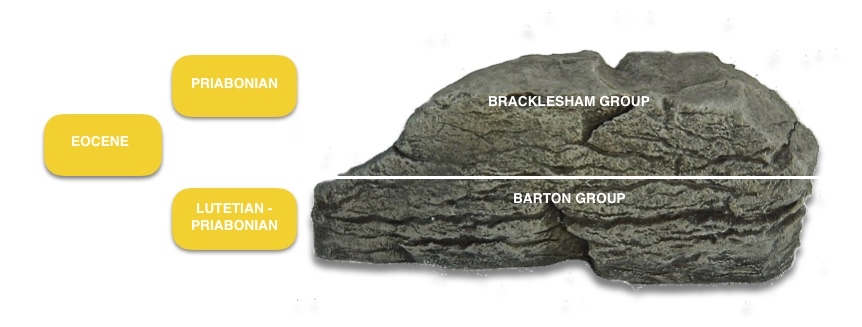Latchmoor Brook is one of the only places where you can see fossils in the New Forest. They come from the uppermost Bracklesham Group sediments and the lowermost Barton Clay. The stream and banks are very shallow, which makes collecting here far easier than other stream-based locations. Gastropods, bivalves and fish remains are all common here.
DIRECTIONS
♦ Latchmoor Brook is found to the south of Bradsham Telegraph, within Studley Wood, and east of Fordingbridge. From Fordingbridge, take the B3078. At the junction of the B3078 and B3080, turn right and, almost immediately, you will find a car park at Bradshaw Telegraph. Alternatively, from the M27, take the B3079 at Junction 1.
♦ At Brook, take the B3078 and follow this until you get to the Bradshaw Telegraph car park. If you reach the B3079 turnoff, you have gone too far. Once at the car park, follow the footpath to the southwest (on the other side of the road) and follow it down until the path veers towards the east. You will then see a hill in the distance.
♦ The stream is just before this in the area of low, open land. Note that the stream here makes the land quite boggy. When you get to the boggy area, follow the stream to the right.
♦ The best area for finding fossils is from the path all the way to the woods.
♦ Ref: 50.943390, -1.677205
PROFILE INFO
FIND FREQUENCY: ♦♦♦♦♦ – Latchmoor Brook is full of different sorts of fossils. Although larger fossils such as large fish vertebrae can be found, most of the fossils tend to be small fish remains, small sharks’ teeth and microfossils. You can also find hard clay nodules full of fossil shells. COLLECTING FOSSILS AND DIGGING IS NOT PERMITTED AND MUST NOT BE CARRIED OUT.
CHILDREN: ♦ to ♦♦♦♦ – During summer, this location is suitable for children to visit, since the brook is wide, shallow and has degraded sides. This makes it an ideal place to explore. However, in winter and during wet periods, the mud can be dangerous and so the site is not recommended.
ACCESS: ♦♦♦ – Latchmoor Brook is fairly easy to find, being about 800m from the Bradshaw Telegraph car park. If you follow the path from here, it will eventually lead to an area of soft and often boggy land. Therefore, make sure you take Wellington boots. The brook is wide, shallow and has degraded sides, so it is best to visit during drier months.
TYPE: – This location is a stream-based location. The Bracklesham and Barton Clay can be seen in the riverbed, but are all mixed together resulting in a mess of mud, mixed pockets of shells and the occasional hard nodule. Therefore, it is very hard to separate the different beds here. This site in the New Forest is managed by the Forestry Commission. COLLECTING FOSSILS AND DIGGING IS NOT PERMITTED AND MUST NOT BE CARRIED OUT.
FOSSIL HUNTING
Latchmoor Brook is a wonderful location to visit within the New Forest and is most suited to those interested in microfossils, although larger fossil fish remains and sharks’ teeth can also be found here. What makes this site much easier to collect from is that the Brook here is wide, shallow and without any steep sides. You can walk along the riverbed during the drier months of the year. The sides and much of the base is overgrown, but there are many areas of clay and pockets of shells, which have been disturbed by the horses that roam freely here.
The best area to collect from is the riverbed itself, because decalcification during weathering occurs to fossil exposed above the water. This results in shells becoming friable and it is not easy to obtain unbroken specimens. The best shells come from a greater depth in the mud, but are often brought to the surface by the action of deer.
You can sometimes find pockets of compacted shells among the clay. These are the richest beds of Bracklesham age and contain the best fossils, such as fish remains. These appear as cream or white shelly material. Look out for hard concretions or nodules, which are packed with fossil shells. However, there is STRICTLY NO COLLECTING OR DIGGING allowed.

GEOLOGY
The brook cuts through the Eocene aged clays, sands and silts of the Bracklesham Group (Lutetian) and the Barton Group (Lutetian – Priabonian). However, it is hard to separate distinctive beds, as most of these have been mixed up within the brook itself and the stratigraphy has been the subject of much argument!
The eastern section of Latchmoor Brook can reveal abundant fossils, from time to time, within places in the sandy-greenish clay in the stream bed. The fossiliferous exposures are very patchy and lie about 2.6m below the land surface.


SAFETY
This is a fairly safe area to visit, although you should be careful of any very boggy ground, especially during winter. During very wet periods, the site can become dangerous due to the mud.
EQUIPMENT
The brook is very muddy and you will certainly need Wellington boots. A trowel or a knife is also very handy and sample bags should be taken to take samples back home. Please note you will need permission from the forestry permission to collect.
ACCESS RIGHTS
COLLECTING FOSSILS AND DIGGING IS NOT PERMITTED AND MUST NOT BE CARRIED OUT UNDER ANY CIRCUMSTANCES.
This site is a site of special scientific interest (SSSI). This means you can visit the site, but hammering the bedrock is not permitted. For full information about the reasons for the status of the site and restrictions, download the PDF from Natural England.
It is important to follow our ‘Code of Conduct’ when collecting fossils or visiting any site. Please also read our ‘Terms and Conditions‘
LINKS
♦ Buy Fossils, Crystals, Tools
♦ Location Discussions
♦ Deposits Magazine
♦ Join Fossil Hunts
♦ UK Fossils Network













































